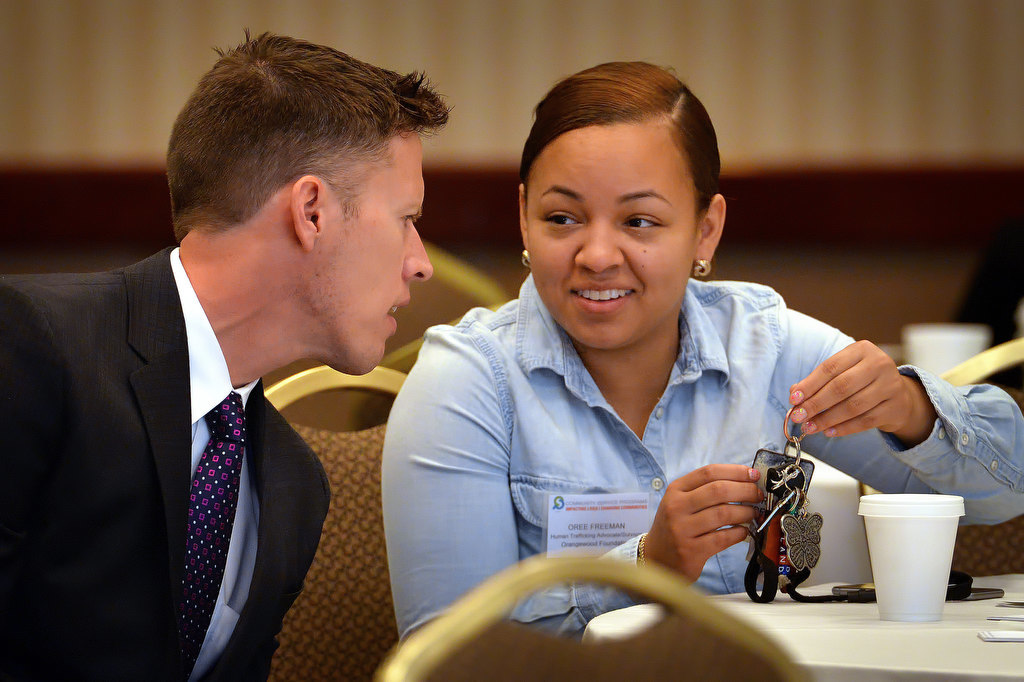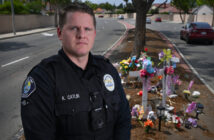A pimp recently arrested for hunting for girls on social media has written a letter to the FBI asking them to take over his case because Orange County law enforcement is too tough on sex crimes.
Another recently jailed pimp was asked by law enforcement which county in Southern California was the toughest to work in.
Orange County, was his answer.
“The police here are completely out of control,” he wrote. “They are all over the place setting people up all the time. The pimps go to prison and the hos go free. I am never coming back to this county. I’m out.”
Apparently, the word is out.

Orange County Deputy District Attorney Brad Schoenleben, a prosecutor in the human trafficking unit, speaks at the 12th Annual Victims’ Rights Conference at the Embassy Suites in Garden Grove.
Photo by Steven Georges/Behind the Badge OC
The Orange County Human Trafficking Task Force is gaining a reputation among pimps as a place you don’t want to do business.
Deputy District Attorney Brad Schoenleben said it warms his heart.
Schoenleben is one of five deputy DAs dedicated to the task force. Other law enforcement agencies that have dedicated men and women to the task force include the Irvine Police Department, Orange County Sheriff’s Department, FBI and California Highway Patrol. The Anaheim Police Department is the lead agency and the Santa Ana PD also is on the task force.
Susan Kang Schroeder, chief of staff for the OCDA, said one of the social media pimp forums (yes, such a thing exists) recently posted one of the task force’s press releases about the crackdown, along with the caption: Stay out of Orange County.
“Word on the street is do not come to Orange County and traffic girls because if you get caught, we are relentless,” Schoenleben told an audience at the 12th annual Victims’ Rights Conference on April 7.

Attendees listen to a seminar titled “Beneath the Surface: Human Trafficking in Orange County,” including Patricia Harris, restitution specialist, victim assistance programs, for Community Service Programs (center, in red jacket), during the 12th Annual Victims’ Rights Conference at the Embassy Suites in Garden Grove.
Photo by Steven Georges/Behind the Badge OC
The conference was hosted by the non-profit Community Service Programs at the Embassy Suites in Garden Grove to honor those in Orange County fighting for victims rights. And enlighten those gathered about the growing menace of human traffickers.
“These guys are right up there (with child molesters),” Anaheim Police Detective Happy Medina told the audience. “I hate these guys. I loathe these guys.”
Medina’s first beat when he started out as a cop 22 years ago was Harbor Boulevard, two stretches of which (in Santa Ana and Anaheim) are nationally known “tracks” for hookers.
“The thing is, (back then) I didn’t realize (the prostitutes) were victims,” he says. “I had been conditioned as a police officer to think of the girls as … criminals, suspects.”
Medina now travels up and down the state holding human trafficking law enforcement workshops to change the old mindset. He, along with other members of the task force and the DA’s office, provides training to law enforcement, educators, social workers, members of faith-based communities, college students, victim advocates and to anyone else interested or wanting information and training regarding human trafficking.

Santa Ana PD Det. Gus Moroyoqul of the Orange County Cold Case Homicide Task Force talks about examining older cases that have been investigated by others and trying to find new leads.
Photo by Steven Georges/Behind the Badge OC
“What I tell all my brothers and sisters in law enforcement is this: ‘You have to make that paradigm shift.’ I’m confessing to you, I had to make a shift.”
Just because a prostitute is over the age of 18 doesn’t mean she has a choice.
“Most of the victims I have spoken to were introduced and recruited to work as prostitutes as a minor,” Medina says. “So all of a sudden, she magically turns 18, and we says she does it because she wants to?”
It’s this shift that is helping the task force hammer away at human trafficking. Or, as Schoenleben calls it, slavery.
“They’re branded,” he says of the girls. “Someone owns them. Someone can sell them. Someone can buy them.”
In fact, in “the life,” if a girl just LOOKS AT another pimp, that pimp has the right to take her. He now owns her.
“When I first heard that I thought, ‘That’s nuts,’” Schoenleben says. “There is no way this is real.”

Orange County Deputy District Attorney Brad Schoenleben leans over to talk to Oree Freeman, a survivor of human trafficking and an advocate for children and young adults being exploited. Both were presenters during a seminar titled “Beneath the Surface: Human Trafficking in Orange County,” at the 12th Annual Victims’ Rights Conference at the Embassy Suites in Garden Grove.
Photo by Steven Georges/Behind the Badge OC
But then he read a text exchange in which a pimp conceded one of his girls to another pimp who invoked the she-looked-at-me-she’s-mine rule with this message. “That’s cool, P. You can have the bitch. Can I at least get my iPhone back?”
The girls are called bitch or ho, never by their name. And they must call their pimps “daddy” or refer to them by their pimp name. Brad just put a man in jail who went by the name Shampoo.
You wear what you are told to wear and only speak to daddy when spoken to, or it’s a punch in the face.
You must also meet your quota, sex with anywhere from 10 to 15 guys a day, bringing in about $1,600. And you don’t get to keep a penny. Don’t make your quota, and it might mean no dinner that night or spending the night in an ice bath in the motel room.
The pimps brand the girls, too, with tattoos of their pimp name, sometimes embellished with crowns and dollars signs.
So where do they get their victims? They cruise the streets looking for girls who look lost, lonely, with nowhere to go. Most runaways report that they were recruited within two days on the street.
“They prey on girls they think they can control,” Schoenleben says.
They also troll the Internet. “Social media is just a big playground and a big recruiting ground for pimps,” Medina says. “And the younger the better.”

T-shirts made by victims are displayed at the 12th Annual Victims’ Rights Conference at the Embassy Suites in Garden Grove.
Photo by Steven Georges/Behind the Badge OC
Once a girl is in “the life,” the pimp takes her property and isolates her. They work a circuit, traveling every few days from city to city: San Diego to OC to LA to Vegas to Sacramento to Seattle, around and around in a big loop.
“It’s not that he needs to chain her to anything, he already controls her,” Schoenleben says. “Sometimes manipulation is a whole lot stronger than a lock on a door.”
One official talks about one girl. Her pimp had pressed a hot iron onto her back, nearly burned off her nipple with a crack pipe and water boarded her. But the scariest moment, she told the official, was when he once threatened to kick her out of the car and leave her in the middle of nowhere.
“She could take a beating all day long,” he says. “But the thing she was most afraid of was being left in the middle of nowhere.”
If there is a steady supply of girls from broken homes, there is an even bigger demand for them.
Prostitution is the second-most profitable criminal enterprise in the world behind narcotics; a $32-billion-a-year global industry, the California Attorney General’s office reports.
Social media has made it easier than ever to find a girl. Every morning, there are 200-300 ads on backpage.com for girls in Orange County.
“It happens all over this county,” Medina says. “Ladera Ranch. Yorba Linda. Costa Mesa. Anaheim. If you have a motel or a place to park a car, you have a human trafficking problem.”
Websites have drop-down menus, essentially order forms. Pick your preferred height, weight, bust size, color — and a girl fitting that description will meet you. Or you can book an Uber to deliver her to your house.
There’s even a site similar to Yelp where Johns rate the prostitutes. It doesn’t help that pop culture glorifies the life.
“Who’s heard of the song ‘Big Pimpin’ by Jay-Z?” Schoenleben asks. “It’s literally about pimping. One of thousands of rap songs out there about pimping. And then Jay Z dines with the president of the United States. How do I combat that?”
TV and film also have a bad habit of romanticizing prostitution. “And then of course, there’s the most famous prostitute of all: ‘Pretty Woman,’” Schoenleben says.
The reality is only 10-15 percent of women out there are working the streets voluntarily. They are called renegades.
“The vast majority on the street are in some way exploited,” Schoenleben says. “You think a 15-year-old wants to bang 10 guys a day every day? That’s a myth.”
So what’s the solution?
Schoenleben doesn’t pretend authorities are going to end prostitution, but they want to make it as hard as possible on the pimps — at least here in Orange County.
“We are putting guys away in prison,” he says.
So far, about 120 pimps have been convicted since the DA joined the task force, and most of them are serving prison time, said Schroeder.
The OC Task Force has flown to Vegas, Sacramento, and just a few weeks ago Florida, to drag some of these thugs back to Orange County and prosecute them.
“We will follow you,” Schoeleben says.
 Behind the Badge
Behind the Badge



